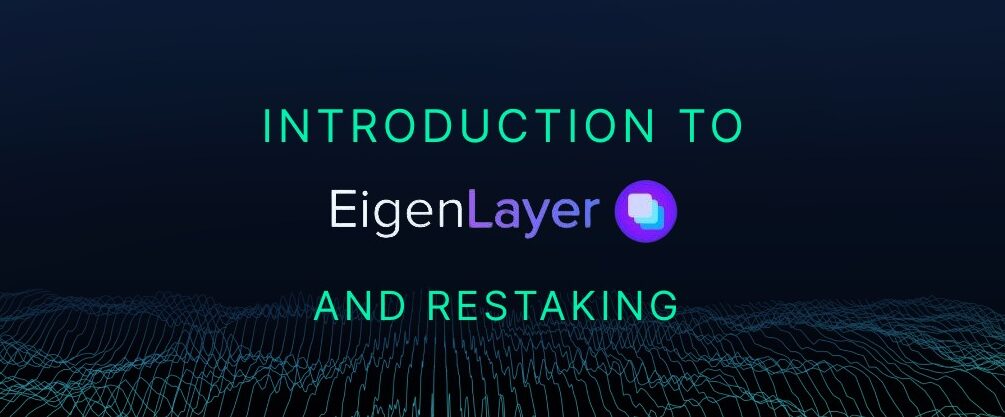Restaking protocol developer, EigenLabs most recently raised $50 million in a Series A round led by Blockchain Capital with participation from Electric Capital, Polychain Capital, Hack VC, Finality Capital Partners, and Coinbase Ventures, among others.
This new funding round, which comes amidst a prolonged bearish period and following the $14.5 million in seed funding in August 2021, will be used by EigenLabs to advance the development of its EigenLayer protocol and accelerate its adoption in the market.
The project aims to address the issue of improving blockchain infrastructure without launching a new blockchain, which requires a new trust network for security.
In September, Ethereum shifted from a proof-of-work (PoW) to a proof-of-stake (PoS) consensus method, replacing miners with validators, or “stakers,” who lock up tokens within the network to help keep it secure in exchange for financial rewards – known as The Merge. EigenLayer’s innovative “restaking” feature enables users to reuse tokens locked up for Ethereum validation to secure other protocols, consolidating security pools and deterring malicious attacks.
What is Restaking?

With the proliferation of Layer-1s, Layer-2s, and subsequent dApps in the crypto space, creating a secure decentralised trust network has been a critical challenge due to being resource-intensive and time-consuming. Not to mention, the security network becomes increasingly fragmented as more applications are built on top of a network.
To overcome this challenge, EigenLayer has introduced the restaking primitive, a new mechanism in cryptoeconomic security that aggregates security across the Ethereum network.
Restaking is a set of smart contracts that allow users to repurpose their locked ETH to provide security for other applications built on the network. EigenLayer creates an opt-in middle layer where users grant the protocol additional enforcement rights on their staked ETH, enabling it to be restaked on other applications. This design creates additional slashing conditions on staked ETH, which helps to facilitate extensible security as new conditions can be introduced to meet the demands of other projects being built on top of Ethereum.
Restaking is available for both natively staked ETH and liquid staked tokens, providing users with the opportunity to earn protocol fees and rewards while providing validation services to new protocols.
EigenLayer’s design further enables staked ETH to provide validation services beyond just Ethereum, providing developers with access to the Ethereum staked capital base and decentralised validator set. This access can make previously impossible mechanism designs possible and optimise usage across nodes, maximising capital efficiency with minimal incremental cost.
According to EigenLabs’ CEO, Sreeram Kannan, “one of the central bottlenecks to innovation in today’s crypto ecosystem is the requirement for projects to bootstrap trust or cryptoeconomic security.” As such, they are building the EigenLayer to create “a new model in which developers can easily consume trust” to focus on innovation and building products rather than bootstrapping security.
EigenLayer’s restaking mechanism addresses the challenge of fragmented security in the Ethereum network, creating a free market for the decentralised trust that enables more agile, decentralised, and permissionless innovation. Restaking is a groundbreaking concept that can potentially transform the future of Web3 by creating a more secure and scalable decentralised trust network.
How Restaking Benefits Ethereum Stakers?

EigenLayer is a revolutionary platform that enables Ethereum stakers to opt into providing validation services for new software modules built on top of the Ethereum ecosystem.
By opting into EigenLayer, stakers can validate a wide range of modules, including consensus protocols, virtual machines, oracle networks, and threshold cryptography schemes. Unlike other platforms that fragment security between modules, EigenLayer aggregates ETH security across all of them, enhancing the security of decentralised applications (DApps) that rely on these modules.
Moreover, EigenLayer creates a free market for decentralised trust, where Ethereum stakers can restake their tokens to provide validation services to the modules of their choice. These services can be offered directly by operating nodes or via delegation to other EigenLayer operators. EigenLayer also allows the creation of a variety of lightweight and hyperscale modules designed for widespread participation from solo stakers.
Additionally, modules can leverage the heterogeneity between stakers on different axes, including computational capacity, risk/reward preferences, and identity, to maximise security and decentralisation.
This way, EigenLayer ushers in a new era of permissionless innovation, where innovators can rely on the security and decentralisation provided by Ethereum restakers via EigenLayer, without building their own trust networks.
Pooled Security

As for the challenges in the security models of protocols built on top of Ethereum, EigenLayer’s restaking mechanism uses pooled security and free-market governance to address them. This enables the extension of Ethereum’s base layer security to any protocol, regardless of its composition.
Restaking creates a pooled security system that optimises using staked ETH as collateral to secure Ethereum. Once users opt-in to EigenLayer, their staked ETH is repurposed to provide validation services to other protocols in return for additional rewards.
EigenLayer enforces this by obtaining the rights of the staked ETH’s withdrawal credentials and the ability to impose new slashing conditions on the stake. This incentivises participation in restaking and honest behaviour, as on-chain verifiable slashing can be applied to capital.
Free-market governance allows protocols to control the amount of pooled security consumed while allowing validators to determine their preferred set of risk and reward parameters before providing services to a given protocol. By allowing validators to selectively choose which protocols to bootstrap, it creates a competitive market for pooled security. Restaking accelerates innovation and increases profitability from staking while mitigating the burden of bootstrapping network security for new protocols.
Additional Slashing Conditions

The platform consists of a set of smart contracts that allow stakers to grant additional slashing conditions on their staked Ether, thereby increasing cryptoeconomic security.
To enforce security, EigenLayer uses smart contracts to manage withdrawal credentials for staked ETH and enforces new slashing conditions if malicious activity occurs. This allows EigenLayer to slash the remaining 50% of staked ETH on the protocol, increasing the cost of malicious attacks.
EigenLayer’s security design success relies on a rebalancing algorithm that accurately accounts for validators and their security capacity and usage. If this mechanism fails, EigenLayer opens itself up to different attack vectors, replicating the vulnerabilities it sought to solve with merge-mining.
Under the current Ethereum network design, stakers can only have up to 50% of their total staked ETH slashed, whereas EigenLayer can enforce slashing on the remaining 50%. This mechanism would function similarly to an over-collateralised loan, adding more capital into the enforcement component. Users, therefore, risk losing more than all of their staked ETH if they act maliciously, setting a strong precedent for honest behaviour.
Increased Revenue Opportunity for All

Restaking through EigenLayer allows ETH stakers to gain additional revenue streams, enhancing value accrual and incentivising participation.
By opting into EigenLayer’s restaking mechanism, Ethereum validators can earn additional revenue by providing validation services to other protocols built on top of Ethereum. Through EigenLayer, protocols can buy pooled security from ETH validators, while validators can sell pooled security to protocols, creating a mutually beneficial ecosystem. This removes many of the inefficiencies within current security models and accelerates innovation across Ethereum while simultaneously increasing the profitability from staking.
As for end users, stakers that opt-in to EigenLayer earn additional rewards on their staked ETH, which we highlighted above.
In traditional staking, capital is not always efficient, as token holders often lock their capital into a contract to earn rewards for contributing to network security, which means they may have to forgo other investment opportunities.
While liquid staking has made staking more capital efficient, it requires users to be more proactive and have the necessary skills, resources, and timing to earn additional yield. And it is also not without risk, as any loss on the extension of capital is a loss on the underlying capital.
Restaking allows users to enhance their earnings potential by allowing for passive rewards on their extended capital. Instead of being locked in a single revenue stream on ETH, the same capital investment can now be rehypothecated to additional protocols with their own reward systems.
This allows for increased diversification and the potential for even greater returns. However, it is important to note that users who opt-in to EigenLayer are still at risk of slashing on the consensus layer, in addition to the new slashing conditions imposed by the protocol.
But this is not all.
The implementation of EigenLayer could offer significant benefits to Ethereum’s fee model. With this model, the created value flow increases in tandem with the network’s growth. As Ethereum provides security to the various dApps built on its platform, these dApps can send fees back to Ethereum in exchange for this service.
While Ethereum’s model is highly effective, it is limited to EVM compatibility, which restricts its potential to other protocols. EigenLayer can overcome this limitation by enabling other protocols to participate in the Ethereum ecosystem without having to build their own security pool.
By doing so, EigenLayer can keep the value flow locked within Ethereum and drive more revenue back to the network. This creates a virtuous cycle of growth and innovation that benefits all participants in the ecosystem.
Conclusion

The Seattle-based blockchain infrastructure company EigenLabs, which has a highly experienced team with a background in tech companies like Amazon Web Services, Meta Platforms (formerly Facebook), and Microsoft, sets out to roll out its EigenLayer protocol in stages throughout the year.
The protocol allows users to restake tokens locked up for validating Ethereum to help secure other protocols. At the same time, EigenLayer aggregates Ether security across modules, increasing the security of decentralised applications relying on the modules.
This way, EigenLayer paves the way for permissionless innovation by leveraging the security and decentralisation provided by ETH restakers via the protocol without building their own trust networks.









